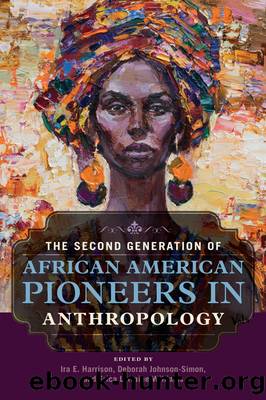The Second Generation of African American Pioneers in Anthropology by Ira E. Harrison

Author:Ira E. Harrison
Language: eng
Format: epub
Publisher: University of Illinois Press
Published: 2018-01-15T00:00:00+00:00
Education
Mabel Gwaltney mounted an effort to get John in the program that would give him the best education her visually impaired son could receive. So she wrote a letter to First Lady Eleanor Roosevelt about John and the hopes she had for him. In response, Mrs. Roosevelt helped place John in a special public school program for blind children. In grade school his favorite subject was geography, in part because of the stories of his fatherâs travels but also because of the CBS national radio program American School of the Air and one of the showâs special guests, anthropologist Margaret Mead, who talked about various societies she had researched and observed.
During Johnâs senior year in high school, his mother became ill with diabetes, a chronic disease that can lead to cardiovascular problems and death. Despite her illness, however, she still insisted that John go on to college. He decided to attend Upsala College in East Orange, so that he could be close to home. Sadly, his mother died shortly before he graduated from Upsala in 1952 with a bachelorâs degree in history and sociology.4
After graduating from college, Gwaltney received a scholarship to continue his education at the New School for Social Research in New York City. One of his primary areas of study was the effects of European colonialism in Africa. Gwaltney earned his masterâs degree in political science and sociology from the New School in 1957. Shortly after graduating, Gwaltney accepted a teaching job at the Henry George School of Social Sciences in New York City. The job enabled Gwaltney to develop his teaching skills as well as earn money to continue his education. In 1959, he began taking courses toward a doctoral degree at Columbia University. One of his professors there was Margaret Mead, the anthropologist who had sparked his interest in studying other cultures twenty years earlier. Gwaltney had always wanted to conduct research as a field anthropologist, which would involve living among the people he was studying for a period of time. Dr. Mead was very encouraging and helped him to plan a research project that took him to San Pedro Yolox, Mexico.
Upon returning to the United States in 1966, Gwaltney wrote a dissertation outlining all that he learned about life in San Pedro Yolox. One thing he discovered was that the Chinantec people treated the blind with profound respect and believed that they were protected from harm by supernatural forces. In fact, each blind person was assigned a child as a helper and guide, and the children viewed this sort of assignment as an honor.
In 1967, Gwaltney completed his dissertation and earned his PhD from Columbia. The faculty of the school was so impressed with his research project that they presented him with the Ansley Dissertation Award, the highest award for a doctoral candidate at Columbia. Out of several hundred people who received doctoral degrees that year, only thirteen people were even recommended for the award. His doctoral defense was praised by his mentor and advisor, Margaret Mead, as âone of the most brilliant PhD oral examinations in my long experience.
Download
This site does not store any files on its server. We only index and link to content provided by other sites. Please contact the content providers to delete copyright contents if any and email us, we'll remove relevant links or contents immediately.
Hit Refresh by Satya Nadella(8993)
When Breath Becomes Air by Paul Kalanithi(8260)
The Girl Without a Voice by Casey Watson(7775)
A Court of Wings and Ruin by Sarah J. Maas(7554)
Do No Harm Stories of Life, Death and Brain Surgery by Henry Marsh(6839)
Shoe Dog by Phil Knight(5078)
Hunger by Roxane Gay(4829)
A Higher Loyalty: Truth, Lies, and Leadership by James Comey(4789)
The Rules Do Not Apply by Ariel Levy(4787)
Everything Happens for a Reason by Kate Bowler(4610)
Tuesdays with Morrie by Mitch Albom(4593)
The Immortal Life of Henrietta Lacks by Rebecca Skloot(4447)
Millionaire: The Philanderer, Gambler, and Duelist Who Invented Modern Finance by Janet Gleeson(4294)
How to Change Your Mind by Michael Pollan(4255)
All Creatures Great and Small by James Herriot(4189)
The Money Culture by Michael Lewis(4025)
Man and His Symbols by Carl Gustav Jung(4008)
Elon Musk by Ashlee Vance(3985)
Tokyo Vice: An American Reporter on the Police Beat in Japan by Jake Adelstein(3901)
